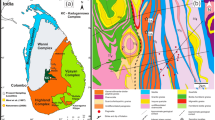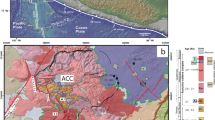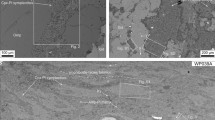Abstract
Throughout the ultrahigh-pressure (UHP) metamorphic unit of the Dora-Maira massif, western Alps, pyrope megablasts contain the typical assemblage clinochlore–kyanite–talc–rutile ± phlogopite ± ellenbergerite as prograde inclusions. In the upper part of the UHP unit in Val Gilba, some megablasts (XMg=0.89–0.98) contain in addition polymineralic inclusions consisting of various combinations of enstatite, gedrite, sapphirine, clinochlore, talc, magnesiostaurolite and rare corundum or spinel. We present evidence that these assemblages developed from cracks running across the megablasts, and are therefore of late origin, post-dating the highest-pressure stage. Enstatite (XMg=0.94–0.99) contains 0.7 to, typically, 3 wt% Al2O3, but up to 8.4 wt% in the presence of sapphirine. Sapphirine (XMg=0.96–0.998, Be-free) shows the largest compositional variations, with Si contents ranging from 1.7 to at least 2.1 atoms pfu, thereby clearly exceeding the 2:2:1 stoichiometry. The late-stage talc contains up to 4 wt% Al2O3, 0.35 wt% Na2O and 0.6 wt% F; gedrite 1.1–2.9 wt% Na2O and up to 0.36 wt% F. The successive development within pyrope of alternative hydrous assemblages involving first enstatite plus an Al-rich phase (kyanite, sapphirine, magnesiostaurolite) ± clinochlore, then a gedrite compositionally close to pyrope, then talc plus an Al-rich phase (sapphirine, corundum), is a clear record of decompression. However, the temperature conditions implied under the assumption of high H2O activity are 100 to 150 °C higher than, and so inconsistent with existing constraints on the decompression path. These constraints are in particular the stability of talc + phengite in the matrix assemblage during decompression, and the absence of regional evidence for a granulite-facies event. This inconsistency can only be alleviated if H2O activity inside the garnet megablast was (or became) considerably reduced with respect to that in the matrix. Fluid influx into an opening fracture in garnet, sealing of the fracture by breakdown products of pyrope and continued evolution under closed-system conditions may have led to increasing solute concentration and such low H2O activity within the garnet megablast, driving the microsystem toward fluid-absent conditions. Micrometre-size inclusions of Ca-sulfate and crandallite-type compounds in minerals of these reactive areas may be evidence for such residual brines and suggest that these were phosphate- and sulfate- rather than halide-dominated. This finding is additional evidence for the very local control that fluid composition and H2O activity may have on the occurrence of granulite-facies assemblages, regardless of temperature. It highlights the role of deformation (here fracturing) in triggering reactions in otherwise unreactive systems. It also shows how carefully inclusion- to-host relationships have to be considered, post-growth reaction within the host being more common than hitherto reported.
Similar content being viewed by others
Author information
Authors and Affiliations
Additional information
Received: 4 February 1999 / Accepted: 24 August 2000
Rights and permissions
About this article
Cite this article
Simon, G., Chopin, C. Enstatite–sapphirine crack-related assemblages in ultrahigh-pressure pyrope megablasts, Dora-Maira massif, western Alps. Contrib Mineral Petrol 140, 422–440 (2001). https://doi.org/10.1007/s004100000198
Published:
Issue Date:
DOI: https://doi.org/10.1007/s004100000198




